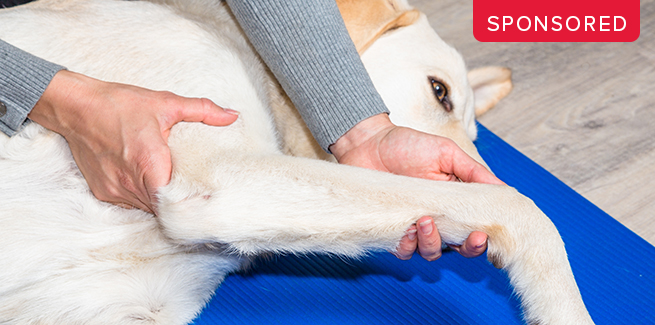New advances in non-invasive treatment options for small animal patients

A creative sales pitch and anecdotal evidence can make any treatment modality seem like a great choice but finding a non-invasive therapy that is backed by scientific evidence proving safety and efficacy can be difficult.
Electrohydraulic Shockwave Therapy is one exception, as this therapy has more than 20 years of clinical, published research proving its efficacy in treating veterinary patients. Until recently, shockwave therapy required small animal patients to be lightly sedated due to potential discomfort associated with the high-energy sound waves the technology generates. However, a new handpiece released by PulseVet Technologies, the X-Trode, allows for the same energy to be deposited to a greater focal area. This new technology takes the sting out of treatment and diminishes the need for sedation in small animals. The energy is applied superficially and deposited in the tissue at areas of density change. The physical stimulus to the cells causes the release of anti-inflammatory, angiogenic, and osteogenic proteins that decrease inflammation, aid in pain relief, and improve tissue and bone healing1,2,3.
There are over 20 scientific based treatments for equine and canine indications, including tendon and ligament injuries, bone healing, osteoarthritis, chronic pain, and wound healing.
Results of a prospective study performed by Kate Barnes, DVM, MS, CCRP, DACVS‐SA, at Louisiana State University showed increased weight bearing at 2 and 8 weeks after TPLO using peak vertical force and vertical impulse measurements4. Patients received two PulseVet shockwave treatments post-operatively. In comparison, there was a steady improvement in ground force reactions in the shockwave treated group compared to a decrease in the non-treated group. In addition to bony healing, shockwave therapy may increase comfort and use of the limb post-TPLO.
In a study by Darryl Millis, MS, DVM, DACVS, DACVSMR, CCRP, and Marti Drum DVM, PhD, DACVSMR CCRP, CERP ,at the University of Tennessee, dogs with hip and elbow osteoarthritis received a single electrohydraulic shockwave treatment5. Steady improvement was shown from day 0 to day 28 when compared to baseline in peak vertical force, comfortable range of motion, and lameness at both a walk and trot. Dogs in the control group showed a continuous decline in these measurements when compared to baseline, highlighting the value of shockwave treatment in osteoarthritis.
Dogs with chronic back pain may also see pain relief with shockwave therapy6. A large prospective study is currently being conducted at Ohio State University by Nina Kieves, DVM, DACVS, DACVSMR, CCRT. Shockwave has been proven effective at pain relief in humans7, and this study will add to the objective data showing shockwave as an effective therapy for chronic lower back pain in dogs.
When it comes to adding non-invasive treatment modalities to the practice, finding one with the scientific research to support its use can be difficult. Both doctors and pet owners want to know that the treatment they are recommending and investing in is effective. Electrohydraulic Shockwave therapy has the clinical evidence to support its use for musculoskeletal indications and now that sedation is no longer required, can be a trusted modality to offer clients that provides consistent, effective, and safe results
Written by Jennifer Vitucci, DVM, CCRT
1 Kersh,KD, McClure,SR, Evans,RB. The evaluation of extracorporeal shock wave therapy on collagenase induced superficial digital flexor tendonitis. Vet Comp Orthop Traumatol 2006;19:99–105
2 Chen, YJ, Wang, CJ, Yang, KD, et al. Extracorporeal shock waves promote healing of collagenase-induced Achilles tendinitis and increase TGF-β1 and IGF-I expression. J Orthop Res 2004;22:854–861
3 Wang, CJ, Wang, FS, Yang, KD. Biological mechanism of musculoskeletal shockwaves. International Society for Musculoskeletal Shockwave Therapy—ISMST 2004;1:5–es 11
4 Barnes, K, Faludi, A, Takawira, C, et al. Extracorporeal shock wave therapy improves short-term limb use after canine tibial plateau leveling osteotomy. Veterinary Surgery. 2019; 1-9
5 Francis, DA, Millis, DL, Evans, M, Moyers, T. Clinical Evaluation of Extracorporeal shock wave therapy for management of canine osteoarthritis of the elbow and hip joint. Presented at the VOS Conference, 2004.
6 Young, JK, Jenkins-Mushetto, L, Leeds, EB. Qualitative evaluation of ESWT for treatment of cauda equina syndrome in dogs and cats. Abstract
7 Elchami, Z, Issa, B, Massoud, R, Diaz, EA, Tannous, R. Effectiveness of using extracorporeal shock wave therapy for the treatment of lower back pain. Presented at the World Institute of Pain, 2012.



